In Conversation...
Esther Schipper & Jochen Meyer
Die Berliner Galerien Esther Schipper und Meyer Riegger sind schon länger auf dem ostasiatischen Kunstmarkt aktiv. Mit der Eröffnung von Galerieräumen in Seoul in Südkorea verstärken beide ihre Präsenz in der Region. Im Westen ist asiatische Kunst sichtbarer denn je – die jüngste Installation der koreanischen Künstlerin Mire Lee in der Turbinenhalle der Tate Modern ist nur ein Beispiel dafür. Die Art Basel verzeichnete 2024 einen Zuwachs an asiatischen Galerien um 20 Prozent und aktuell präsentiert das Gallery Weekend Berlin mehrere asiatische Künstler*innen und lockt junge, dynamische Sammler*innen aus Asien in die deutsche Hauptstadt. Auch in umgekehrter Richtung gibt es großes Potenzial für Präsenz. Um herauszufinden, welche Synergieeffekte zwischen Ost und West möglich sind, hat sich Kimberly Bradley mit Esther Schipper und Jochen Meyer von Meyer Riegger zum Gespräch getroffen.
Kimberly Bradley: Wann – und weshalb – habt ihr eure Galerien in Korea eröffnet?
Esther Schipper: Ich hab schon 2017 in Korea ein Unternehmen gegründet, mit der Idee, eine Galerie zu eröffnen. Es kam dann etwas anders als gedacht – aber wir hatten eine koreanische Firma und während der Pandemie hatten wir jemanden vor Ort in Seoul. In den Monaten, in denen hier in Europa nichts möglich war, konnte sie dort sehr viel erreichen. Also haben wir das Team um eine weitere Person erweitert, um lokale Messen und Projekte zu organisieren. Schließlich haben wir eine dritte Person eingestellt und ein Büro eröffnet … das zunächst als Showroom diente und dann zu einer Galerie wurde. Jetzt sind wir an einen anderen Standort umgezogen, der nach dem Mondneujahr dieses Jahres eröffnet wurde.
Jochen Meyer: Ich bewundere Esther immer für ihre strukturierte Herangehensweise! Ich kann auch bestätigen, dass Asien vor allem während der Pandemie der umsatzstärkste Kontinent für uns war. Das begann schon vor der Pandemie mit den Messen Art Basel Hong Kong und Westbund Shanghai und natürlich mit der Frieze Seoul. Wir hatten uns ein starkes Netzwerk aus Sammler*innen aufgebaut, auf das wir zurückgreifen konnten. Dennoch diskutierten wir lange ob es besser ist, möglichst viele Messen zu organisieren oder eine eigene Galerie in Asien zu eröffnen. Am Ende haben wir uns für Seoul entschieden und dann wurde uns ein Galerieraum angeboten, in dem wir letzten September mit drei Ausstellungen gestartet sind. Jetzt ziehen wir wieder um, im September eröffnen wir den neuen Raum. Wir haben mit der Pariser Galerie Jocelyn Wolf ein Unternehmen gegründet. Mit Jocelyn verbindet uns eine langjährige Freundschaft, wir teilen die gleichen Werte und haben ein ähnliches Selbstverständnis von Galeriearbeit. Die neue Galerie in Seoul wird Meyer Riegger Wolf heißen. Für uns ist das ein neues, Modell, ein neues Umfeld, ein neuer Kontinent.
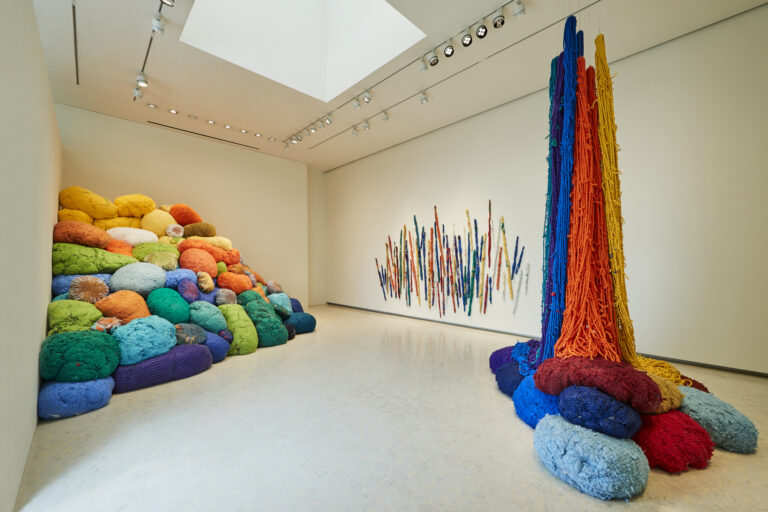
Sheila Hicks, Another Gap in the Wall. Branches, cotton, linen, pigmented acrylic fiber. Talking Stick. Pigmented acrylic fiber, cotton, linen, stick, slate, leather. Landing Pigment, acrylic fiber. Variable dimensions. Courtesy of the artist
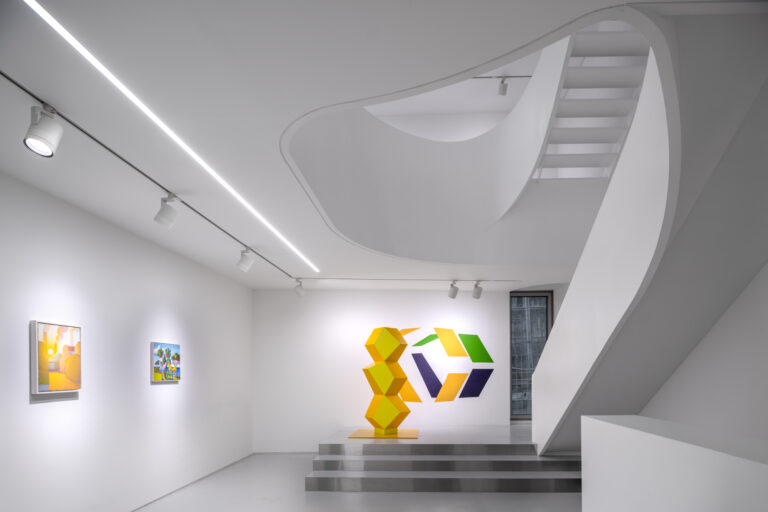
Exhibition view: Conversations, Esther Schipper, Seoul, 2025
Courtesy the artist and Esther Schipper, Berlin/ Paris/Seoul
Photo © Hyun Jun Lee
Was waren die größten Herausforderungen beim Aufbau der Galerien in Korea?
JM: In Korea ein Unternehmen zu gründen, ist eine bürokratische Herausforderung. Und natürlich leben wir in einer Welt, die sich ständig verändert. Aber eine Galerie zu gründen und an einen neuen Standort zu ziehen, ist bisher sehr positiv.
ES: Man macht Pläne, und dann stellt man fest, dass es nicht ganz so läuft, wie man es sich vorgestellt hat. Dann probiert man etwas Anderes aus, und plötzlich läuft es gut. Aber auch wenn wir in Korea gut im Geschäft sind und unsere Künstler*innen bereits große institutionelle Ausstellungen hatten, lerne ich immer noch viel dazu. Und je mehr ich lerne, desto mehr Fragen tauchen auf. Als ich im Januar zum ersten Mal das M+ [ein Museum für zeitgenössische Kunst in Hongkong] besucht habe, wurde mir klar, dass asiatische Museen, mit Ausnahme von Japan, ihre ständigen Sammlungen moderner und zeitgenössischer Kunst nicht permanent ausstellen. Das MMCA in Seoul zum Beispiel hat eine große Sammlung und zeigt regelmäßig thematische Ausstellungen über koreanische Kunst. Aber es gibt keine ständige Ausstellung über koreanische Kunst von 1920 bis heute, in der Besucher*innen etwas über das künstlerische Erbe der Region erfahren könnten. Ich sehe also eine Menge Kunst, aber man muss selbst recherchieren, Fragen stellen, lesen und die Dinge in einen Kontext stellen. Das ist sehr interessant, aber im Moment auch eine große Herausforderung – und ein Schwerpunkt meiner Arbeit. Außerdem findet ein Austausch stattn, d. h. wir integrieren koreanische Künstler*innen in das Programm der Galerie, und sind im ständigen Dialog.
Wie sehen asiatische Sammler*innen und das asiatische Publikum europäische Kunst, und umgekehrt?
ES: Künstler*innen auf dem Markt vorzustellen nimmt in beide Richtungen ähnlich viel Zeit in Anspruch. Nicht alle Künstler*innen, die bei uns bekannt sind, kennt man auch in diesem Teil der Welt und umgekehrt. Und glücklicherweise sind Menschen meistens sehr neugierig. Wenn wir eine Künstler*in in Korea zum ersten Mal präsentieren, kann es passieren, dass sie zunächst keine Resonanz finden, aber sechs Monate oder ein Jahr später das Interesse plötzlich da ist. Und institutionelle Anerkennung ist von Bedeutung – wenn man in Seoul eine Künstler*in vorstellt, die von den großen europäischen Museen gesammelt wird, schafft das Vertrauen.
JM: Nicht-kommerzielle Galeriearbeit ist ebenfalls wichtig. Wir glauben an die Werke, die wir zeigen, auch wenn sich die Künstler*innen nicht sofort verkaufen. Der kulturelle Wert einer Galerie wird auch durch Veröffentlichungen und Talks erzeugt. Das ist einer der Gründe, warum wir nach Seoul gehen.
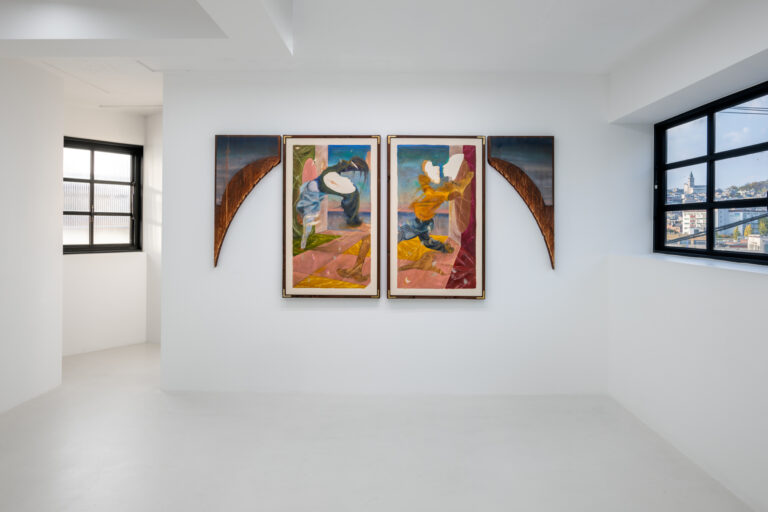
Exhibition view: Thomias Radin, Old Soul – New
Soul, Esther Schipper, Seoul, 2024. Courtesy the artist and Esther Schipper, Berlin/Paris/Seoul Photo © Hyun Jun Lee
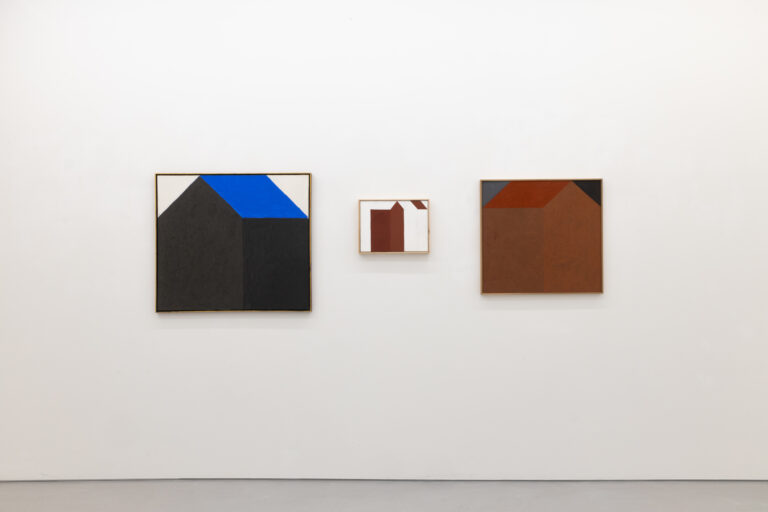
Horst Antes – ‘Eine Form von Figur’, Meyer Riegger, Seoul. Images courtesy of the artist and Meyer Riegger
Ist das Sammlungsverhalten in Korea aus Sicht einer Galerie anders als in Europa?
ES: In Korea gibt es generell mehr Spontaneität. Die Sammler*innen kaufen schneller.
JM: Genau wie die chinesischen Sammler*innen.
ES: Vor allem in Nordeuropa neigen die Leute dazu abzuwägen und brauchen Zeit für ihre Entscheidungen. In Korea sind Prozesse meistens schneller. Und ein anderer Faktor, den wir oft sehen, ist dass bei den koreanischen und anderen asiatischen Sammler*innen, die für sich selbst kaufen, die Wohnräume und Häuser traditionell viel kleiner sind – wir müssen also überlegen, ob ein Werk durch die Tür passt!
Welche demografischen Merkmale haben die Sammler*innen?
JM: Wir waren dieses Jahr auf der Art Basel Hong Kong und es war unglaublich: Jeden Tag so viel Trubel, so viel Energie und so viele Verkäufe, vor allem bei den jungen Leuten. Das war einer der Gründe, warum wir die Galerie dort eröffnen wollten. Man spürt, dass der Kunstmarkt dort eine Zukunft hat. Hier in Deutschland gibt es wirklich viele großartige Sammler*innen, aber sie werden älter. Und es ist unklar, wie sich die Sammlerschaft entwickelt. In China und Korea folgt die neue Generation ganz natürlich.
Woran liegt das?
ES: In den Ländern, über die wir sprechen, aber auch in Indonesien oder auf den Philippinen, gibt es ein kunstinteressiertes Publikum, das der ersten oder zweiten Generation angehört, die das Land nach Konflikten und politischen Spannungen aufgebaut hat. Sie haben einen anderen Zugang als ihre Kinder, Enkel oder Urenkel. Ich glaube auch, dass die zeitgenössische Kultur in diesen Ländern einen sehr hohen Stellenwert hat. Die Leute gehen gerne in Ausstellungen. Ich bin keine Soziologin und kann keine wissenschaftlichen Vergleiche ziehen, und natürlich ist die Zahl der Ausstellungsbesuche auch hier in Europa gestiegen. Trotzdem habe ich das Gefühl, dass das Publikum in Seoul sehr entdeckungsfreudig und wissbegierig ist. Wir sind nur ein kleiner Teil davon, aber das Gesamtbild ist beeindruckend.
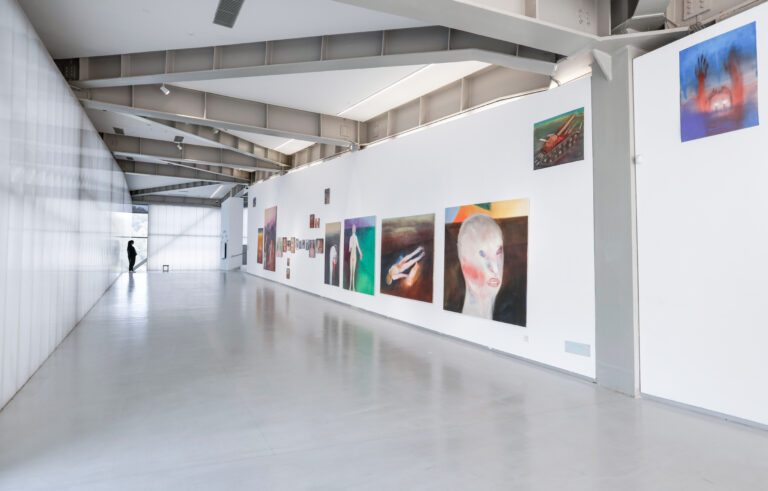
Miriam Cahn – ‘Ten Thousand Things’, Sifang Art Museum, Nanjing, 2020
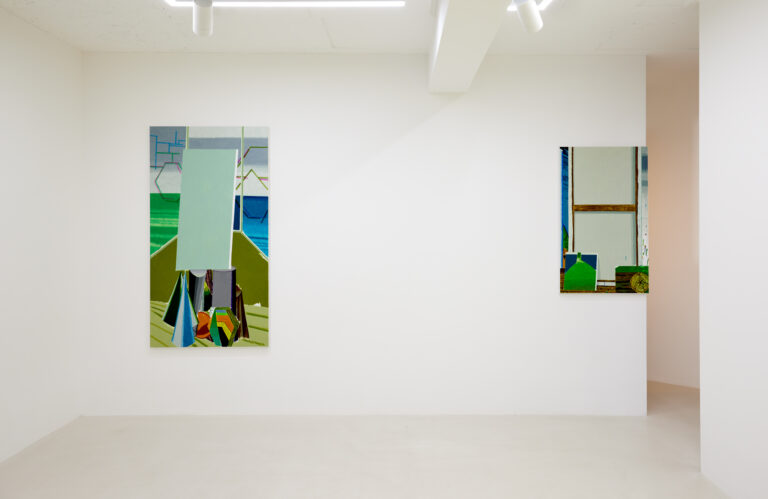
Exhibition view: 뒤집기 / Dui Jip Ki, Esther Schipper, Seoul, 2023. Courtesy the artists and Esther Schipper, Berlin/Paris/Seoul Photo © Sangtae Kim
Wenn man die reinen Zahlen betrachtet, haben Festlandchina und Hongkong immer noch einen Anteil von etwa 85 Prozent am gesamten asiatischen Kunstmarkt. Hat eine*r von euch jemals daran gedacht, eine Galerie in einer anderen asiatischen Stadt zu eröffnen?
ES: Ich liebe Hongkong, aber ich kann mir im Moment nicht vorstellen, dass sich dort etwas in unserem Sinne entwickelt. Ich liebe auch China, aber aktuell ist es nicht der richtige Zeitpunkt, um dort eine Galerie zu eröffnen. Wir haben darüber nachgedacht, ein Pop-up in Shanghai zu machen – eine aufregende Stadt. Aber die Entwicklung ist schwer einzuschätzen. In Japan ist das ganz anders: Wir haben dort viele Projekte umgesetzt, arbeiten gut mit unseren japanischen Kolleg*innen zusammen und haben tolle Sammler*innen. Aber ich hatte immer das Gefühl, dass es sehr viele Ebenen gibt, die wir erst erschließen müssen, bevor es denkbar ist, eine Galerie in Tokio zu eröffnen.
JM: Korea scheint in vielerlei Hinsicht viel offener zu sein. Wir haben ein kleines Büro in Shanghai, aber es war sehr schwierig, dort oder in Hongkong etwas zu eröffnen. Wir verkaufen mehr an chinesische Sammler*innen und Museen als an koreanische. Korea hat sich jedoch in den letzten Jahrzehnten durch eine gewisse politische Stabilität ausgezeichnet. Außerdem gab es dort zumindest von den 1960er bis in die 1980er Jahre eine Kunstgeschichte und einen Kunstmarkt, die sich parallel zum Westen entwickelt haben. Ästhetik und Wissen sind dem westlichen Umfeld ähnlicher als in anderen asiatischen Ländern. Hier können wir leichter anknüpfen.
Arbeiten die Galerien in Seoul im Rahmen von ähnlichen Veranstaltungen wie dem Gallery Weekend Berlin zusammen?
ES: In Berlin haben wir uns zusammen getan, um ein internationales Publikum zu begeistern und in die Stadt zu locken. In Seoul ist die Szene eher aufgesplittert. Eine koreanische Galerie verkauft, glaube ich, zu 95 Prozent in Korea.
JM: Es wäre gut, wenn es so etwas wie das Gallery Weekend in Seoul gäbe. In diesem Frühjahr war die Kunstmesse „Collaborations“ geplant, die von einer Gruppe aus Sponsor*innen, Galerien und Sammler*innen ins Leben gerufen wurde. Sie wurde jedoch aufgrund der politischen Ereignisse im Dezember 2024 verschoben. Die Zusammenarbeit steckt im Allgemeinen noch in den Kinderschuhen. Aber ja, wir versuchen immer noch, die Zusammenhänge zu verstehen und lernen viel dazu.
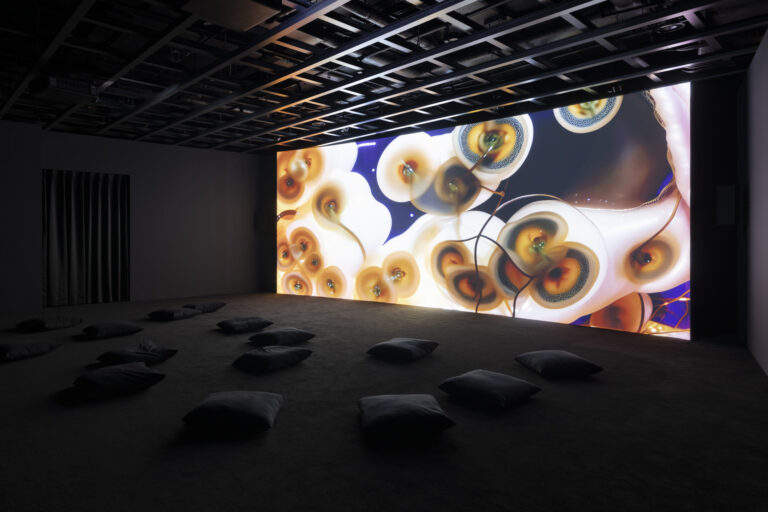
Anicka Yi, There Exists Another Evolution but in This One, Leeum Museum of Art, Seoul, 2024. Courtesy the artist, Leeum Museum of Art, Gladstone Gallery and Esther Schipper, Berlin/Paris/Seoul. Photo © Andrea Rossetti © Anicka Yi / VG Bild-Kunst, Bonn 2025
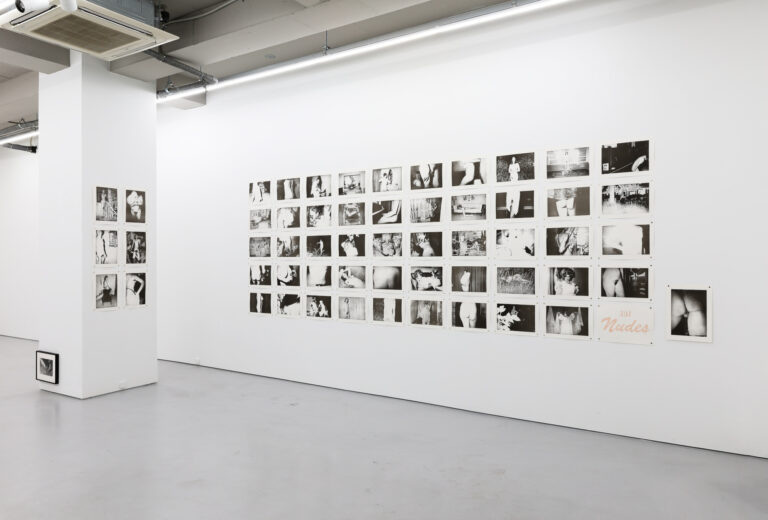
Jimmy DeSana – ‘Subversions’, Meyer Riegger, Seoul. ©️ Jimmy DeSana Trust. Image courtesy of the Jimmy DeSana Trust, Meyer Riegger and P·P·O·W, New York. Photos by baufoto
Seit der Pandemie macht ihr beide etwa 30 Prozent eurer Geschäfte in Asien. Kommen auch Sammler*innen aus asiatischen Ländern zum Gallery Weekend?
ES: Wir stellen zum Gallery Weekend eine junge chinesische Malerin [Sun Yitian] aus. Und eine Gruppe chinesischer Sammler*innen kommt zu Besuch.
JM: Letztes Jahr haben wir beim Gallery Weekend ein wichtiges Werk an eine koreanische Sammlerin verkauft, die wir damals noch nicht kannten. Sie hatte unsere Ausstellungen in Seoul besucht und war von der Arbeit eines jungen lateinamerikanischen Künstlers [Santiago de Paoli] begeistert. Sie kaufte das größte Werk der Ausstellung. Ich habe den Eindruck, dass viele Asiat*innen nach Europa kommen, um die Kultur und Kunst hier vor Ort zu erleben – man sieht sie auf den Messen in Basel und Paris, und auch im kleineren Rahmen spürt man ihre Präsenz in Europa. Auch das Gallery Weekend investiert mehr in die Kommunikation in Asien. Dort gibt es einfach so viel Potenzial.
In Conversation...
Esther Schipper & Jochen Meyer
Berlin galleries Esther Schipper and Meyer Riegger have long been active in the eastern Asian art market—and both are strengthening their presence in the region by opening gallery spaces in Seoul, South Korea. While the art market is shifting everywhere, Asian art feels more present than ever in the West—Korean artist Mire Lee’s recent installation at Tate Modern’s Turbine Hall is just one example. In 2024, Art Basel in Basel last year saw a 20 percent uptick in Asian gallery participation, and now, Gallery Weekend Berlin is positioning itself as a strong draw for showing Asian artists as well as attracting young, energetic Asian collectors to the German capital. There’s plenty of potential for just as much exposure in the other direction. What synergies are possible between East and West? Kimberly Bradley met with Esther Schipper and Jochen Meyer of Meyer Riegger to find out.
Kimberly Bradley: When—and why—did you open your Korean galleries?
Esther Schipper: I registered a business in Korea in 2017 with the idea to open a gallery. That didn’t turn out the way we thought—but we had a registered Korean company, and during the pandemic, we had someone on the ground in Seoul. In the months in which nothing was possible here in Europe, she was able to do quite some work. So, we added another person to the team to do local fairs and projects. Eventually we hired a third person, and opened an office … which became a showroom, and then a gallery. Now we’ve moved to another venue that opened after Lunar New Year this year.
Jochen Meyer: I always admire Esther, because she’s so structured! But I would agree that, especially during the pandemic, Asia was the strongest continent for us in terms of sales. It started before the pandemic with the fairs Art Basel Hong Kong and Westbund in Shanghai, and of course Frieze Seoul. We’d built a strong collector network that we could rely on. For a long time we discussed whether it was better to do so many fairs or have a physical gallery space in Asia. We decided in the end on Seoul, and then we were offered a gallery space and started with three shows last September. Now we are moving again, we will open the new space in September. We have founded a company with the Parisian gallery Jocelyn Wolf. We have a long-standing friendship with Jocelyn, we share the same values and have similar views on gallery work. The new gallery in Seoul will be called Meyer Riegger Wolf. For us, this is a new model, new environment and a new continent.

Sheila Hicks, Another Gap in the Wall. Branches, cotton, linen, pigmented acrylic fiber. Talking Stick. Pigmented acrylic fiber, cotton, linen, stick, slate, leather. Landing Pigment, acrylic fiber. Variable dimensions. Courtesy of the artist

Exhibition view: Conversations, Esther Schipper, Seoul, 2025
Courtesy the artist and Esther Schipper, Berlin/ Paris/Seoul
Photo © Hyun Jun Lee
What were the primary challenges in establishing a gallery in Korea?
JM: Founding a company in Korea is bureaucratically challenging. And, of course, we’re in a changing world. But founding a gallery and now moving to a new location has felt very positive so far.
ES: Like everywhere, you make plans, and then you see, oh, this is not quite the way we thought it was going to go, and then you try other things out, and suddenly it works out well. But even if we’ve done a lot of business in Korea and our artists have done big institutional exhibitions, I’m still learning. And the more I learn, the more questions I have. When I went to M+ [a major contemporary art museum in Hong Kong] the first time in January, I realized that Asian museums, with the exception of Japan, don’t have their permanent modern and contemporary collections on view. The MMCA in Seoul, for instance, has a large collection and regularly does thematic exhibitions of Korean art, but does not always have a collection of Korean art from 1920 till today on view, where people could learn about the region’s artistic legacy. So, you see a lot of art, but you have to do your own research, ask questions, read, and put things into context. It’s very interesting, but this is my biggest challenge and focus at the moment. There also needs to be an exchange, which means integrating Korean artists to the gallery’s program, or at least starting a conversation.
How do Asian collectors and audiences view European art, and vice-versa?
ES: Introducing artists takes an equal amount of time in both directions. Not every artist who is renowned here is known in that part of the world, and vice versa. But people are very curious. In Korea, the introduction of an artist might not seem to resonate, but then six months or a year later, you suddenly see more interest. And institutional recognition adds a lot of value—if you introduce an artist in Seoul who has been collected by the big European museums, it builds trust.
JM: The noncommercial part of running a gallery is also important. We believe in the work we show, even if an artist doesn’t sell immediately. A gallery’s cultural value is also generated with publications and talks. This is part of why we’re going to Seoul.

Exhibition view: Thomias Radin, Old Soul – New
Soul, Esther Schipper, Seoul, 2024
Courtesy the artist and Esther Schipper, Berlin/Paris/Seoul Photo © Hyun Jun Lee

Horst Antes – ‘Eine Form von Figur’, Meyer Riegger, Seoul. Images courtesy of the artist and Meyer Riegger
From a gallerist’s point of view, is collecting behavior in Korea different than in Europe?
ES: There’s generally more spontaneity in Korea. Collectors buy faster.
JM: So do Chinese collectors.
ES: Especially in Northern Europe, people tend to be extremely cautious and need time to make a decision while in Korea the processes are quicker. And for the Korean and other Asian collectors who buy for themselves, and we should not forget that living spaces and houses are traditionally much smaller—we have to consider if a work will fit through a door!
What are the collector demographics?
JM: We were in Hong Kong for Art Basel Hong Kong this year. It was incredible: There was so much excitement, energy, and sales, every day, especially from the young generation. This is one reason why we wanted to open the gallery there, because you feel there is a future. Here in Germany, especially, you have so many great collectors, but they are getting older, and there’s no clear succession plan. In China and Korea, the new generation is growing naturally.
Why?
ES: In the countries we’re talking about, but also in Indonesia or the Philippines, you have a generation interested in art who are either the first or the second generation who built up the country after conflicts and political tensions. They approach things with a different energy than their children, grandchildren, or great-grandchildren. I also think that the value of contemporary culture is a very important good in these countries. People love going to exhibitions. I’m not a sociologist, and I cannot compare, and of course, the numbers of exhibition-goers here in Europe has also increased. But I feel that the Seoul audience’s hunger to discover and learn is very promising. We are only a small part of that, but it’s a much bigger picture.

Miriam Cahn – ‘Ten Thousand Things’, Sifang Art Museum, Nanjing, 2020

Exhibition view: 뒤집기 / Dui Jip Ki, Esther Schipper, Seoul, 2023. Courtesy the artists and Esther Schipper, Berlin/Paris/Seoul Photo © Sangtae Kim
Mainland China and Hong Kong still hold about 85 percent of the overall Asian art market, if you look at raw figures. Did either of you ever consider opening a gallery in another Asian city?
ES: I love Hong Kong, but I couldn’t see things developing there for us. I also love China, but it’s not the right time to open there. We thought for a moment of opening a pop-up in Shanghai because it’s an exciting, energetic place, but it’s unpredictable. Japan is a whole other story: We did many projects, work well with our Japanese colleagues, and have incredible collectors there. But I always had the feeling that there are many layers we’d need to access before it was even thinkable to open a gallery in Tokyo.
JM: Korea in many ways seems much more open. We have a small office in Shanghai but found it very challenging to open something there or in Hong Kong. We sell more to Chinese collectors and museums than to Korean ones, but Korea has over recent decades been characterized by a certain political stability. And you also have, at least from the 60s to the 80s, an art history and art market whose growth parallels the Western market. The aesthetics and knowledge are more similar to the Western situation than in other Asian countries. This is something we can connect to more easily.
Do the galleries in Seoul collaborate with each other in events similar to Gallery Weekend Berlin?
ES: It’s more compartmentalized in Seoul. In Berlin we needed to be very supportive to each other, so that people from outside would come and visit us. But a Korean gallery has, I would think, 95 percent Korean sales.
JM: It would be good to have something like Gallery Weekend in Seoul. There was an art fair launch this spring, called “Collaborations,” planned by a group of backers, galleries, and collectors, but it was postponed due to the political events of December 2024. Collaboration, in the general sense, is still in the early phases, and like I said, we are still trying to understand and learn.

Anicka Yi, There Exists Another Evolution but in This One, Leeum Museum of Art, Seoul, 2024. Courtesy the artist, Leeum Museum of Art, Gladstone Gallery and Esther Schipper, Berlin/Paris/Seoul. Photo © Andrea Rossetti © Anicka Yi / VG Bild-Kunst, Bonn 2025

Jimmy DeSana – ‘Subversions’, Meyer Riegger, Seoul. ©️ Jimmy DeSana Trust. Image courtesy of the Jimmy DeSana Trust, Meyer Riegger and P·P·O·W, New York. Photos by baufoto
You both do about 30 percent of your business in Asia since the pandemic. Do collectors from Asian countries also come to Gallery Weekend?
ES: We’re showing a young Chinese painter for Gallery Weekend, and a delegation of Chinese collectors is coming over.
JM: Last year at Gallery Weekend, we sold an important work to a Korean collector we didn’t know at the time. She’d seen our shows in Seoul. She loved the work of a young Latin American artist, and bought the biggest piece in the show. It seems to me that many Asians come to Europe to experience the culture and art here—you can see it at the fairs in Basel and in Paris in Europe and feel it on a smaller scale, too. Even Gallery Weekend is investing more in communications to Asia. There’s just so much potential.
